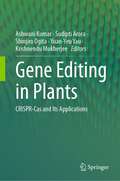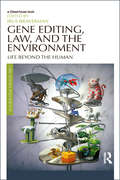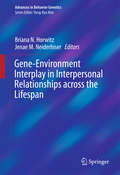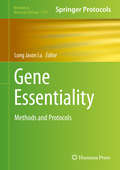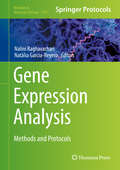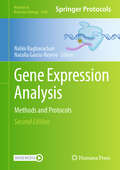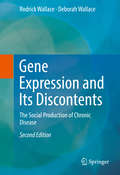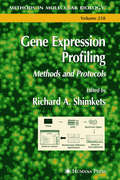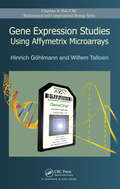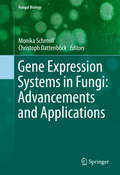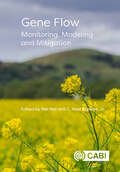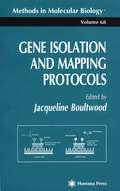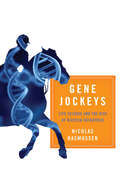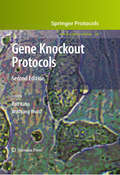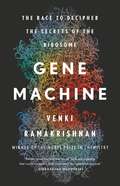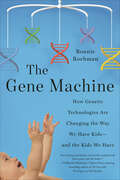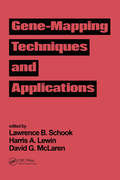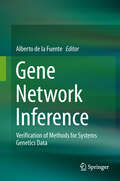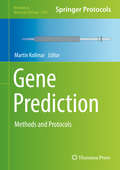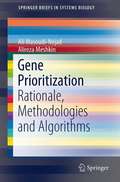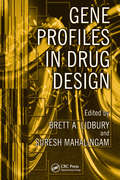- Table View
- List View
Gene Editing in Plants: CRISPR-Cas and Its Applications
by Ashwani Kumar Sudipti Arora Shinjiro Ogita Yuan-Yeu Yau Krishnendu MukherjeeThis book is a collection of information about applying CRISPR-Cas systems for genome editing in plants. The main focus of this book is to address the recent advances and future prospects of CRISPR-Cas technology in crops.Genome editing technology is important because it can be used to improve plant traits. The earlier genome-engineering tools, zinc finger nucleases (ZFNs), and TAL effector nucleases (TALENs) are complicated to design and not flexible. The novel genome editor, CRISPR-Cas systems, has advantages over ZFNs and TALENs. The advantages are simple and easy to design precision in targeting and efficiency. Due to its precision and simplicity, the CRISPR-Cas technology has rapidly become the most popular genome-editing platform in life-science fields. CRISPR-Cas technology has been used widely for human gene therapy to treat diseases and for plant breeding programs for crop improvement.This book is of interest and useful to genome-editing professionals, plant breeders, horticulturists, field-level extension workers, nurserymen, planters, ecologists, and valuable source of reference to the relevant researchers.
Gene Editing, Law, and the Environment: Life Beyond the Human (Law, Science and Society)
by Irus BravermanTechnologies like CRISPR and gene drives are ushering in a new era of genetic engineering, wherein the technical means to modify DNA are cheaper, faster, more accurate, more widely accessible, and with more far-reaching effects than ever before. These cutting-edge technologies raise legal, ethical, cultural, and ecological questions that are so broad and consequential for both human and other-than-human life that they can be difficult to grasp. What is clear, however, is that the power to directly alter not just a singular form of life but also the genetics of entire species and thus the composition of ecosystems is currently both inadequately regulated and undertheorized. In Gene Editing, Law, and the Environment, distinguished scholars from law, the life sciences, philosophy, environmental studies, science and technology studies, animal health, and religious studies examine what is at stake with these new biotechnologies for life and law, both human and beyond.
Gene-Environment Interplay in Interpersonal Relationships across the Lifespan
by Briana N. Horwitz Jenae M. NeiderhiserIntriguing new findings on how genes and environments work together through different stages of life take the spotlight in this significant collection. Studies from infancy to late adulthood show both forces as shaping individuals' relationships within family and non-family contexts, and examine how these relationships, in turn, continue to shape the individual. Transitional periods, in which individuals become more autonomous and relationships and personal identities become more complicated, receive special emphasis. In addition, chapters shed light on the extent to which the quantity and quality of genetic and environmental influence may shift across and even within life stages. Included in the coverage: Gene-environment interplay in parenting young children. The sibling relationship as a source of shared environment. Gene-environment transactions in childhood and adolescent problematic peer relationships. Toward a developmentally sensitive and genetically informed perspective on popularity. Spouse, parent, and co-worker: roles and relationships in adulthood. The family system as a unit of clinical care: the role of genetic systems. Behavioral geneticists, clinical psychologists, and family therapists will find in Gene-Environment Interplay in Interpersonal Relationships across the Lifespan a window into current thinking on the subject, new perspectives for understanding clients and cases, and ideas for further study.
Gene Essentiality
by Long Jason LuThis volume opens by covering two main types of approaches widely used to determine essential genes: single-gene knockouts and transposon mutagenesis, in both prokaryotes and Candida albicans. Given the significant advancement in the computational predictions of microbial essential genes, the second half of the book examines four main types of approaches: comparative genomics, supervised machine learning, constraint-based methods, and corrections of transposon mutagenesis data, as well as databases and servers that are often used in studying gene essentiality. Written in the highly successful Methods in Molecular Biology series format, chapters include an introduction to their respective topics, lists of the necessary materials and reagents, step-by-step, readily reproducible laboratory protocols, and tips on troubleshooting and avoiding known pitfalls. Authoritative and up-to-date, Gene Essentiality: Methods and Protocols will aid researchers who wish to further our knowledge in this vital field of study.
Gene Expression Analysis: Methods And Protocols (Methods in Molecular Biology #1783)
by Nalini Raghavachari Natàlia Garcia-ReyeroThis volume provides experimental and bioinformatics approaches related to different aspects of gene expression analysis. Divided in three sections chapters detail wet-lab protocols, bioinformatics approaches, single-cell gene expression, highly multiplexed amplicon sequencing, multi-omics techniques, and targeted sequencing. Written in the highly successful Methods in Molecular Biology series format, chapters include introductions to their respective topics, lists of the necessary materials and reagents, step-by-step, readily reproducible laboratory protocols, and tips on troubleshooting and avoiding known pitfalls. Authoritative and cutting-edge, Gene Expression Analysis: Methods and Protocols aims provide useful information to researchers worldwide.
Gene Expression Analysis: Methods and Protocols (Methods in Molecular Biology #2880)
by Nalini Raghavachari Natalia Garcia-ReyeroThis second edition volume expands on the previous edition with updates on the latest methodologies in the transcriptomics field. The chapters in this book cover topics such as spatial omics, long-read sequencing technology, tissue microarrays, analysis of saliva and extracellular vesicles, machine learning and artificial intelligence-based approaches for analysis of singe cells transcriptome, and large sets of data on multi-omics including transcriptomics. Written in the highly successful Methods in Molecular Biology series format, chapters include introductions to their respective topics, lists of the necessary materials and reagents, step-by-step, readily reproducible laboratory protocols, and tips on troubleshooting and avoiding known pitfalls. Cutting-edge and practical, Gene Expression Analysis: Methods and Protocols, Second Edition is a valuable resource for advanced undergraduate and graduate students studying gene expression analysis, and scientists interested in learning more about this rapidly advancing field.
Gene Expression and Its Discontents
by Rodrick Wallace Deborah WallaceThis book describes how epigenetic context, in a large sense, affects gene expression and the development of an organism, using the asymptotic limit theorems of information theory to construct statistical models useful in data analysis. The approach allows deep understanding of how embedding context affects development. We find that epigenetic information sources act as tunable catalysts, directing ontogeny into characteristic pathways, a perspective having important implications for epigenetic epidemiology. In sum, environmental stressors can induce a broad spectrum of developmental dysfunctions, and the book explores a number of pandemic chronic diseases, using U. S. data at different scales and levels of organization. In particular, we find the legacy of slavery has been grossly compounded by accelerating industrial decline and urban decay. Individual chapters are dedicated to obesity and its sequelae, coronary heart disease, cancer, mental disorders, autoimmune dysfunction, Alzheimer's disease, and other conditions. Developmental disorders are driven by environmental factors channeled by historical trajectory and are unlikely to respond to medical interventions at the population level in the face of persistent individual and community stress. Drugs powerful enough to affect deleterious epigenetic programming will likely have side effects leading to shortened lifespan. Addressing chronic conditions and developmental disorders requires significant large-scale changes in public policy and resource allocation.
Gene Expression Profiling
by Richard A. ShimketsLeading scientists in gene expression methodology and bioinformatics data analysis describe readily reproducible methods for measuring RNA levels in cells and tissues. The techniques presented include new methods for applying the Affymetrix GeneChip®, SAR-SAGE, StaRT-PCR, SSH, the Invader Assay®, and ADGEM. The authors also provide critical bioinformatics insight and resources for data analysis and management. By distilling the basic underlying principles of many methods to a few straightforward concepts, investigators can easily choose the method most appropriate to their application.
Gene Expression Studies Using Affymetrix Microarrays (Chapman & Hall/CRC Computational Biology Series)
by Hinrich Gohlmann Willem TalloenThe Affymetrix GeneChip system is one of the most widely adapted microarray platforms. However, due to the overwhelming amount of information available, many Affymetrix users tend to stick to the default analysis settings and may end up drawing sub-optimal conclusions. Written by a molecular biologist and a biostatistician with a combined decade of
Gene Expression Systems in Fungi: Advancements and Applications
by Monika Schmoll Christoph DattenböckBiotechnology has emerged as one of the key environmentally safe technologies for the future which enables use of biomass to develop novel smart materials and to replace oil derived products. Fungi are the most efficient producers of the enzymes needed for this purpose and in addition they produce a plethora of secondary metabolites, among which novel antibiotics can be found. Industrial application and exploitation of the metabolic capacities of fungi requires highly productive and robust gene expression systems, which can be achieved by selection of appropriate species and strain improvement. In this book we aim to summarize homologous and heterologous gene expression systems of fungi for production of enzymes and secondary metabolites. A broad overview on requirements, challenges and successful applications shall serve as a basis for further development of fungi as biotechnological workhorses in research and industry.
Gene Flow: Monitoring, Modeling and Mitigation
by Wei Wei And C. Neal Stewart JrGene flow is a natural process that occurs spontaneously and enables the evolution of life. However, with the release of genetically modified organisms, concerns have focused on introduced foreign transgenes and their dispersal in nature through gene flow. This book examines gene flow of transgenes, such as herbicide resistance genes, with the goal of understanding the factors that may affect the process of gene flow. A greater biological understanding is essential to make sound management regulatory decisions when also taking into consideration the processes that happen in conventional plants. Monitoring, modelling, and mitigation are the three most closely related elements of gene flow. The book includes both scientific reviews and perspectives on gene flow and experimental case studies, including studies of gene flow in soybean and poplar. The authors present diverse views and research methodologies to understand transgene flow. This book: Focuses on applications of gene flow (monitoring, modelling, and mitigation); Includes both review chapters and case studies; Is written by international team of scientists currently working in gene flow. This book will be valuable for students and researchers in genetics, biotechnology, plant science, and environmental science. It also provides key insights of value to regulators of biotechnology as well as policy-makers.
Gene Function Analysis
by Michael F. OchsWith the advent of high-throughput technologies following completion of the human genome project and similar projects, the number of genes of interest has expanded and the traditional methods for gene function analysis cannot achieve the throughput necessary for large-scale exploration. This book brings together a number of recently developed techniques for looking at gene function, including computational, biochemical and biological methods and protocols.
Gene Isolation and Mapping Protocols
by Jacqueline BoultwoodAn unprecedented collection of all the most up-to-date techniques for gene isolation and mapping, including the latest methods for gene characterization using database analyses. This collection of thoroughly tested recipes also includes chapters for the computational analysis of novel cDNA sequences with up-to-the-minute information on basic sequence analysis, sequence similarity searches, exon detection and similarity searches, and the prediction of gene function. Its state-of-the-art methods constitute indispensable tools for all scientists engaged in the search for specific disease genes, or in the general advancement of the human genome project.
Gene Jockeys: Life Science and the Rise of Biotech Enterprise
by Nicolas RasmussenThe scientific scramble to discover the first generation of drugs created through genetic engineering.The biotech arena emerged in the 1970s and 1980s, when molecular biology, one of the fastest-moving areas of basic science in the twentieth century, met the business world. Gene Jockeys is a detailed study of the biotech projects that led to five of the first ten recombinant DNA drugs to be approved for medical use in the United States: human insulin, human growth hormone, alpha interferon, erythropoietin, and tissue plasminogen activator.Drawing on corporate documents obtained from patent litigation, as well as interviews with the ambitious biologists who called themselves gene jockeys, historian Nicolas Rasmussen chronicles the remarkable, and often secretive, work of the scientists who built a new domain between academia and the drug industry in the pursuit of intellectual rewards and big payouts. In contrast to some who critique the rise of biotechnology, Rasmussen contends that biotech was not a swindle, even if the public did pay a very high price for the development of what began as public scientific resources. Within the biotech enterprise, the work of corporate scientists went well beyond what biologists had already accomplished within universities, and it accelerated the medical use of the new drugs by several years.In his technically detailed and readable narrative, Rasmussen focuses on the visible and often heavy hands that construct and maintain the markets in public goods like science. He looks closely at how science follows money, and vice versa, as researchers respond to the pressures and potential rewards of commercially viable innovations. In biotechnology, many of those engaged in crafting markets for genetically engineered drugs were biologists themselves who were in fact trying to do science.This book captures that heady, fleeting moment when a biologist could expect to do great science through the private sector and be rewarded with both wealth and scientific acclaim.
Gene Knockout Protocols
by Ralf Kühn Wolfgang WurstWith the completion of the mouse and human genome sequences, the functional characterization of every mammalian gene and the deciphering of their molecular interaction network has become the next major challenge, and the mouse genome provides a convenient and vital model for these studies. In "Gene Knockout Protocols, Second Edition", distinguished contributors with extensive experience in the gene targeting and mouse genetics fields reveal a comprehensive collection of step-by-step laboratory protocols. Emphasizing the many new mutagenesis techniques developed over the last seven years, the volume covers topics such as gene modification in ES cells, stem cell manipulation, the generation of genetically engineered mice, and mutant phenotype analysis. Written in the highly successful Methods in Molecular BiologyTM series format, chapters contain brief introductions to their respective subjects, lists of the necessary materials and reagents, readily reproducible protocols, and notes on troubleshooting and avoiding known pitfalls. Fully updated and authoritative, "Gene Knockout Protocols, Second Edition" provides a unique collection of expert bench protocols certain to be a valuable resource for those just entering the field of gene targeting but also for all genetic researchers today.
Gene Machine: The Race to Decipher the Secrets of the Ribosome
by Venki RamakrishnanFrom Nobel Prize winner Venki Ramakrishnan &‘Beyond superb&’ Bill Bryson &‘A wonderful book&’ Ian McEwan Everyone knows about DNA, the essence of our being, the molecule where our genes reside. But DNA by itself is useless without a machine to decode the genetic information it contains. The ribosome is that machine. Venki Ramakrishnan tells the story of the race to uncover its enormously complex structure, a fundamental breakthrough that resolves an ancient mystery of life itself.
Gene Machine: The Race to Decipher the Secrets of the Ribosome
by Venki RamakrishnanA Nobel Prize-winning biologist tells the riveting story of his race to discover the inner workings of biology's most important molecule"Ramakrishnan's writing is so honest, lucid and engaging that I could not put this book down until I had read to the very end."--Siddhartha Mukherjee, author of The Emperor of All Maladies and The Gene Everyone has heard of DNA. But by itself, DNA is just an inert blueprint for life. It is the ribosome--an enormous molecular machine made up of a million atoms--that makes DNA come to life, turning our genetic code into proteins and therefore into us. Gene Machine is an insider account of the race for the structure of the ribosome, a fundamental discovery that both advances our knowledge of all life and could lead to the development of better antibiotics against life-threatening diseases. But this is also a human story of Ramakrishnan's unlikely journey, from his first fumbling experiments in a biology lab to being the dark horse in a fierce competition with some of the world's best scientists. In the end, Gene Machine is a frank insider's account of the pursuit of high-stakes science.
The Gene Machine: How Genetic Technologies Are Changing the Way We Have Kids—and the Kids We Have
by Bonnie RochmanA sharp-eyed exploration of the promise and peril of having children in an age of genetic tests and interventionsIs screening for disease in an embryo a humane form of family planning or a slippery slope toward eugenics? Should doctors tell you that your infant daughter is genetically predisposed to breast cancer? If tests revealed that your toddler has a genetic mutation whose significance isn’t clear, would you want to know?In The Gene Machine, the award-winning journalist Bonnie Rochman deftly explores these hot-button questions, guiding us through the new frontier of gene technology and how it is transforming medicine, bioethics, health care, and the factors that shape a family. Rochman tells the stories of scientists working to unlock the secrets of the human genome; genetic counselors and spiritual advisers guiding mothers and fathers through life-changing choices; and, of course, parents (including Rochman herself) grappling with revelations that are sometimes joyous, sometimes heartbreaking, but always profound. She navigates the dizzying and constantly expanding array of prenatal and postnatal tests, from carrier screening to genome sequencing, while considering how access to more tests is altering perceptions of disability and changing the conversation about what sort of life is worth living and who draws the line. Along the way, she highlights the most urgent ethical quandary: Is this technology a triumph of modern medicine or a Pandora’s box of possibilities?Propelled by human narratives and meticulously reported, The Gene Machine is both a scientific road map and a meditation on our power to shape the future. It is a book that gets to the very core of what it means to be human.
Gene Mapping, Discovery, and Expression
by Minou BinaA collection of cutting-edge computational tools and experimental techniques to study how genes are regulated, and to reconstruct the regulatory networks through which various cell-types are produced. On the computational side, web-based technologies to localize genes, to access and retrieve data from microarray databases, to conduct comparative genomics, and to discover the potential "codes" in genomic DNA that may control the expression of protein-coding genes. Detailed experimental techniques described include methods for studying chromatin structure and allele-specific gene expression, methods for high-throughput analysis to characterize the transcription factor binding elements, and methods for isolating and identifying proteins that interact with DNA. The protocols follow the successful Methods in Molecular BiologyTM series format, each offering step-by-step instructions, an introduction outlining the principles behind the technique, lists of the necessary equipment and reagents, and tips on troubleshooting and avoiding pitfalls.
Gene-Mapping Techniques and Applications
by Lawrence B. Schook Harris A. Lewin David G. McLarenThis book explains current strategies for mapping genomes of higher organisms and explores applications of gene mapping to agriculturally important species of plants and animals. It also explores the experimental techniques used for genetic and physical mapping of genes.
Gene Network Inference
by Alberto FuenteThis book presents recent methods for Systems Genetics (SG) data analysis, applying them to a suite of simulated SG benchmark datasets. Each of the chapter authors received the same datasets to evaluate the performance of their method to better understand which algorithms are most useful for obtaining reliable models from SG datasets. The knowledge gained from this benchmarking study will ultimately allow these algorithms to be used with confidence for SG studies e. g. of complex human diseases or food crop improvement. The book is primarily intended for researchers with a background in the life sciences, not for computer scientists or statisticians.
Gene Prediction: Methods and Protocols (Methods in Molecular Biology #1962)
by Martin KollmarThis volume introduces software used for gene prediction with focus on eukaryotic genomes. The chapters in this book describe software and web server usage as applied in common use-cases, and explain ways to simplify re-annotation of long available genome assemblies. Written in the highly successful Methods in Molecular Biology series format, chapters include introductions to their respective topics, lists of the necessary computational requirements, step-by-step, readily reproducible computational protocols, and tips on troubleshooting and avoiding known pitfalls.Cutting-edge and thorough, Gene Prediction: Methods and Protocols is a valuable resource for researchers and research groups working on the assembly and annotation of single species or small groups of species. Chapter 3 is available open access under a CC BY 4.0 license via link.springer.com.
Gene Prioritization
by Ali Masoudi-Nejad Alireza MeshkinIdentifying causal genes underlying susceptibility to human disease is a problem of primary importance in the post-genomic era and in current biomedical research. Recently, there has been a paradigm shift of such gene-discovery efforts from rare, monogenic conditions to common "oligogenic" or "multifactorial" conditions such as asthma, diabetes, cancers and neurological disorders. These conditions are referred to as multifactorial because, susceptibility to these diseases is attributed to the combinatorial effects of genetic variation at a number of different genes and their interaction with relevant environmental exposures. The goal of this book is to introduce gene prioritization aspects and the candidate gene prioritization algorithms to give readers a comprehensive view on the subject.
Gene Probes
by Marilena Aquino do Muro Ralph RapleySenior scientists Marilena Aquino de Muro and Ralph Rapley have brought together an outstanding collection of time-tested protocols for designing and using genes probes in a wide variety of applications. The applications covered range from searching for specific genes in the human chromosome to the detection of microorganisms and their toxins in the environment and in food samples, as well as in the diagnosis of human disease. Helpful tutorials explain the principles of gene probe design, labeling, detection, target formation, and hybridization conditions.
Gene Profiles in Drug Design
by Brett A. Lidbury Suresh MahalingamWith the successful mapping of the human genome, we have entered an age of unprecedented opportunity in which researchers are beginning to apply this vast repository of knowledge to the treatment of human disease. Gene-profiling technologies and the concept of individualized medicine are leading to the development of drugs with enhanced specificity
